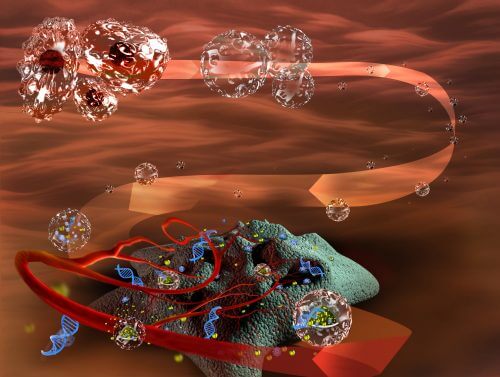The journal Nano Letters reports on an innovative technology developed at the Technion: safe transport of particles that cause the production of an anti-cancer drug in the target cell. In experiments on model animals, the technology doubled the life expectancy after the development of the disease

A new technology for the targeted transport of anti-cancer drugs in the body was developed in the laboratory of Prof. Marcel Mahloof of the Technion. This technology dramatically increases the effectiveness of the treatment and prevents the side effects associated with existing chemotherapy treatments. In experiments conducted on model animals, the system doubled life expectancy after the development of a cancerous tumor in the prostate.
Although treatment of symptoms is an important medical goal, the ultimate goal of medical practice is to eradicate the disease itself by treating its underlying causes. This is of course also true in cancer medicine, which aims to eliminate the cancer tumor and its metastases. Two of the problems in this area are the side effects of chemotherapy drugs and the ability of cancer cells to develop resistance to these drugs.
The good news is that gene therapy, the recipient of research and clinical prosperity in recent decades, is already proving its effectiveness in the treatment of tumors and metastases. The working tool of genetic therapy is the insertion of genes, that is, of nucleic acid sequences that code for the creation of proteins. This tool enables one of the two: (a) the creation of proteins that replace damaged or missing proteins in the target cell, or (b) the introduction of genes that lead to the creation of anti-cancer proteins in the target cell. In this way, it is possible to prevent the development of resistance against chemotherapy treatments as well as to reduce the side effects caused by the dispersion of the toxic drug on its way to the cancerous tumor.
However, despite the great potential inherent in gene therapy in the context of cancer, its clinical application is still very limited. The common method in gene therapy - introducing the genes into the target cells using viruses - provokes in some cases a severe reaction of the immune system. In addition, the current treatments involve "leakage" of the cargo on its way to the cancerous target and the result is damage to healthy tissues and serious side effects as a result.
An article published in the journal Nano Letters heralds a breakthrough in precise transport of genes to the target without the use of viruses. The new technology, developed in the laboratory of Prof. Marcel Mahloof from the Faculty of Biotechnology and Food Engineering at the Technion, is an innovative transfer platform called "Nano Ghost". These are tiny particles made from the outer membrane of specific cells called "mesenchymal stem cells". These cells know how to navigate their way naturally to the cancerous tumor. The technology developed by Prof. Mahlouf together with doctoral student Limor Kanty allows these cells to be produced in the laboratory in large quantities, to empty them of their contents and turn them into a kind of empty packaging - nanometric ghosts. Specific genes are inserted into those packages, which start producing an anti-cancer protein only when they reach the cancerous tumor and therefore do not damage healthy tissues on their way to the target. Furthermore, the anti-cancer protein affects not only the target cells into which the gene is inserted, but also nearby cancer cells as well as the blood vessels that support the tumor and are essential for its survival.
The clinical use of this technology is simple: after being loaded with genetic material, the nanometer ghosts are injected directly into the bloodstream, through which they navigate to the cancerous tumor. Since outwardly these are mesenchymal stem cells, the system recognizes these particles as friendly agents and does not harm them; And since the particles do not release their cargo on the way, they cannot damage healthy tissues. Only after reaching the malignant tissue and settling on it do they insert the gene into the tumor cells and start the production of the anti-cancer protein. It is worth noting that since these particles do not create any immune rejection, there is no need to extract the mesenchymal cells from the patient himself.
Very encouraging data emerges from experiments conducted on model animals: the new technology doubled the life expectancy of the animal after the development of a prostate cancer tumor, and led to a delay of more than 75% in the development of prostate cancer and more than 50% in non-small lung cancer cell lung carcinoma. No side effects or toxicity were observed in the tested animals, a fact that indicates the safety of the system.
Prof. Marcel Mahlouf is a world-renowned researcher in the fields of drug delivery, gene therapy, cellular therapy and tissue engineering. Her laboratory develops and engineers nano-systems and micro-systems for the transport of drugs and genes (as in the current study); in the encapsulation ("packaging") of cellular systems for the treatment of cancer and diabetes; and in the development of scaffolds for heart tissue engineering, blood vessels and the heart. Prof. Mahlouf has published more than sixty articles and book chapters, and seven of her patents are in registration processes.
